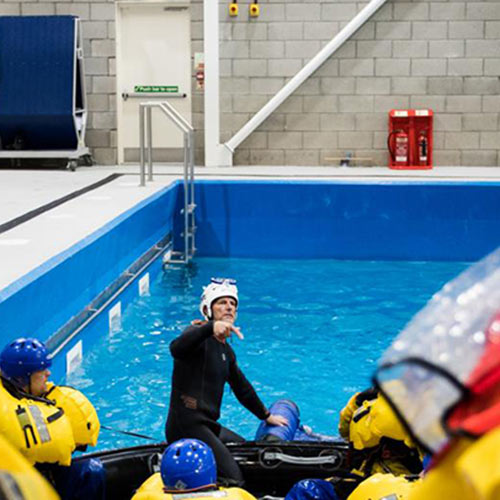OPITO FOET CA-EBS
Cost: $675.00
Duration: Up to 8 Hours depending on number of attendees
Start Time: 11:30 AM
Accreditation
OPITO
Course Code:
5850
Validation:
4 Years
Class Options
- In Person
Locations
- Houston, Texas
We’ve launched an online booking system at booking.allstop.net. Please click the button below to go to the site.
Course Summary

The OPITO-approved Further Offshore Emergency Training program with Compressed Air Emergency Breathing System (CA-EBS) is a 1-day course which must be undertaken by individuals who have a valid BOSIET (with CA-EBS), BOSIET(with EBS), TBOSIET, FOET (with CA-EBS), FOET(with EBS) or TFOET certificate. The FOET (with CA-EBS) certificate re-validates a delegate’s offshore emergency training for a further 4 years.
Please Note: Due to the physical demands of the course, it is the responsibility of the employer and participant to pre-determine the participant’s ability to safely attend the course.
FOET Training in Houston, Texas
Learning Outcomes
HELICOPTER SAFETY AND ESCAPE TRAINING
Assessment Method: Direct Observation
- Donning of an aviation transit suit, an aviation life jacket, compressed air emergency breathing system (CA-EBS) equipment and conducting integrity checks of the CA-EBS equipment, including buddy checks D.5.5 (1)
- Deploying (left and right hand) and breathing from CA-EBS equipment at atmospheric pressure in dry conditions D.5.5 (2)
- Actions to take in preparing for a helicopter emergency landing D.5.5 (3)
- Following instruction from the crew, location of CA-EBS equipment and evacuation from a helicopter using a nominated exit, following a controlled emergency descent to a dry landing (conducted in helicopter simulator at poolside on dry land) D.5.5 (4)
- Actions to be taken in preparing for an in-water ditching including location of exit, deploying and breathing from CA-EBS equipment at atmospheric pressure in dry conditions (conducted in helicopter simulator at poolside on dry land) D.5.5 (5)
- Dry evacuation, using a nominated exit, to an aviation life raft from a helicopter ditched on water (and, on instructions from the aircrew, operation of a push out window), assisting others where possible and carrying out initial actions on boarding the aviation life raft, to include: mooring lines, deploying the sea anchor, raising the canopy and raft maintenance* D.5.5 (6)
- Escaping through a window opening which is underwater, from a partially submerged helicopter (without operation of a push out window)* D.5.5 (7)
- Escaping through a window opening which is underwater, from a partially submerged helicopter (with operation of a push out window)* D.5.5 (8)
- Escaping through a window opening which is underwater, from a capsized helicopter (without operation of a push out window)* D.5.5 (9)
- Following escape from the helicopter (HUET), inflate life jacket, deploy spray visor and carry out in-water procedures, to include swimming, getting into Heat Escape Lessening Position (HELP), towing, chain, huddle and circle* D.5.5 (10)
- Boarding an aviation life raft from the water* D.5.5 (11)
- Being rescued by one of the recognized methods available offshore and survivor actions following rescue* D.5.5 (12)
- Deploying CA-EBS (above the water surface) and breathing from the CA-EBS in a pool, face down in shallow water (at a maximum depth of 0.7m, measured at the chest) D.5.5 (13)
- Deploying CA-EBS (below the water surface, face down in a pool in shallow water) and clearing the mouthpiece by exhaling under the water surface (at a maximum depth of 0.7m, measured at the chest) D.5.5 (14)
- Deploying CA-EBS (below the water surface, face down in a pool in shallow water, using opposite hand to previous exercise) and clearing with purge button under the water surface (at a maximum depth of 0.7m, measured at the chest) D.5.5 (15)
- Deploying CA-EBS (above water surface), in a pool and breathing from CA-EBS underwater in a vertical position (at a maximum depth of 0.7m, measured at the chest) D.5.5 (16)
- Deploying CA-EBS (underwater), in a pool and breathing from CA-EBS underwater in a vertical position (at a maximum depth of 0.7m, measured at the chest) D.5.5 (17)
- Deploying CA-EBS (underwater), in a pool, breathing from CA-EBS underwater, and moving along a horizontal rail for a period of no less than 30 seconds, including a change in direction (at a maximum depth of 0.7m, measured at the chest) D.5.5 (18)
FIRE FIGHTING AND SELF RESCUE TECHNIQUES
Assessment Method: Direct Observation
- Correct use of appropriate hand held portable fire extinguishers and which ones to use for different classes of fires. D.5.6 (1)
- Self-rescue techniques with a smoke hood or partial blindfold from areas where delegate visibility is reduced. D.5.6 (2)
- Self-rescue techniques with a smoke hood or partial blindfold from areas where delegate visibility is completely obscured D.5.6 (3)
- Small group escape techniques with a smoke hood or partial blindfold from areas where delegate visibility is completely obscured D.5.6 (4)
FIRST AID
Assessment Method: Direct Observation
- Raising the alarm D.5.7 (1)
- *Immediate first aid actions, to include industry recognized first aid practice ** D.5.7 (2)




